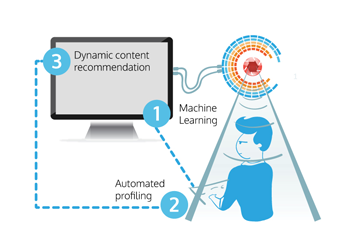Inbound B2B Marketing & the Relevancy Gap

Content + Traffic
Welcome to the content-generation generation, in which B2B marketers spend about a third of their budgets creating content-rich Web experiences in the form of videos, white papers, case studies, webinars and other resources designed to capture interest and business leads. It's a growing trend, with some estimates showing the practice of content marketing up by more than 25 percent since 2012.
Another significant portion of B2B marketing budgets is spent on acquiring Web traffic in an increasingly competitive and thus, costly digital environment.
The two investments - content and traffic - should be working together in your digital enterprise. If you bring users to your site and offer them valuable content, you should be gathering leads. That's the idea anyway.  The problem is that for many B2B sites, there remains a costly disconnect between inbound traffic and rich content. One metric that starkly underscores the gap is bounce rate. BrightInfo's own studies of B2B website landing pages show that an average of 90 percent of anonymous visitors exit after viewing only one page, with just 10 percent retention of that, only about 3 percent convert into leads. Clearly, marketers have a very brief window to make their online marketing budgets pay off, but the great majority of their visitors remain anonymous.
The problem is that for many B2B sites, there remains a costly disconnect between inbound traffic and rich content. One metric that starkly underscores the gap is bounce rate. BrightInfo's own studies of B2B website landing pages show that an average of 90 percent of anonymous visitors exit after viewing only one page, with just 10 percent retention of that, only about 3 percent convert into leads. Clearly, marketers have a very brief window to make their online marketing budgets pay off, but the great majority of their visitors remain anonymous.
Why aren't online marketers getting more value from the content they create?
Continues below....
Get up close and personal with the dynamic content engines - and everything you didn't even know you could personalize.
The problem is a combination of short user attention spans and high volumes of diverse content. The latter is a good thing - designed to ensure every kind of visitor (think IT vs. COO, or those who prefer data points versus rich videos) can access information they care about in the formats they desire. That volume, however, means visitors are typically faced with too much message diversity and choices at once - without a way to quickly and easily discover the information they need.
When all your content references, calls-to-action and offers are aggregated, the noise can be deafening to the typical visitor. Without some sort of intelligent curation, the most content-rich website will present too many irrelevant options to a given user, and away they bounce. Searching your site for relevant material is the Web equivalent of asking a user to flip through microfiche. No one has the time or patience - especially with so many competitive options just a click away.
So, the question is how to get the right (e.g. relevant and in the preferred format) content - in a manageable amount - in front of each consumer within the few seconds you have their attention?
It's possible to target content manually, assigning categories of information to different users based on pre-segmentation criteria. But for the volume of content and diversity of users in play (and given that few small- and mid-sized businesses have the resources necessary to devote to this activity full-time), a manual approach isn't likely to be cost efficient or particularly effective.
A better answer is dynamic, automated content recommendation. Just as dynamic advertising ser ves a tailored advertisement to a consumer based on previous behaviors; marketers need a way to identify the needs and preferences of site visitors in order to promote the most useful marketing materials (content) - in seconds.
Machine learning technologies enable automated user profiling and dynamic content recommendations to promote marketing materials based on individual visitor needs gleaned from the user's entry point and on-site behaviors.
An algorithmic approach can be designed to enable any number of anonymous visitors to be targeted at a high resolution with the ideal subsets of content from even the most enormous libraries. Instead of facing masses of irrelevant content, the user is offered a small set of highly appropriate choices. In seconds, they have what they came for and are that much closer to becoming a lead.
For most B2B websites, spending more on content development and traffic generation is a wasted effort without a way to match the two efficiently. Dynamic content recommendation allows matching to be automated and fluid - delivering instant engagement from existing content resources to turn anonymous users into known leads.
About the Author: As the VP of Marketing, Alit Bar Sadeh leads the marketing and collaborates with the executive team on the sales of the company. With more than a decade of high-tech marketing leadership experience, Alit previously served as VP Marketing for GigaSpaces Technologies and successful startup Cloudyn. She brings to BrightInfo deep expertise in online marketing and cloud technology and is instrumental in driving product strategy and market share. For more information on the topics addressed here, Alit recommends refferring to BrightInfo's white paper.
Subscribe to Our Newsletter!
Latest in Marketing








